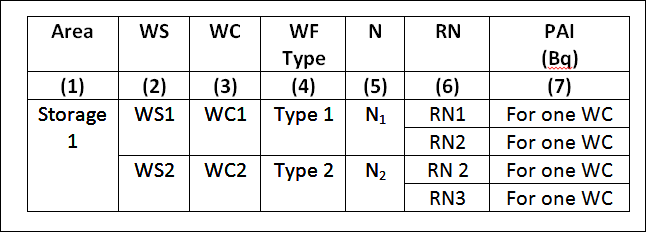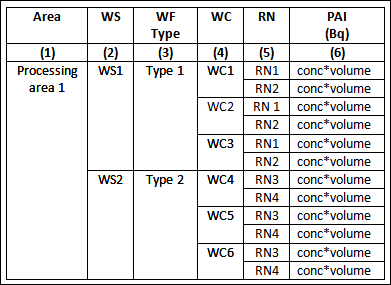PAI
The radionuclide inventory that can be potentially affected by the accident is denoted in SAFRAN as Potentially Affected Inventory (PAI). The PAI will depend on inventory of this radionuclide present in the affected area at the moment of the accident and on the type of accident. The number of waste components that can be potentially affected by an accidental scenario will vary from case to case. Hence, SAFRAN cannot know in advance the PAI values that should be used for quantification of specific impacts. Nevertheless, in the System Description Module SAFRAN prepares for each area a Table with preliminary values of the PAI, based on information of waste components and waste streams entered by the user. Tables 3.1 and 3.2 are examples of the tables created by SAFRAN for storage and processing facilities, respectively.
Table 3.1. Preliminary values of Potentially Affected Inventories calculated by SAFRAN for storage areas.

Definition of columns in Table 3.1:
- Column 1. Short name of the storage area..
- Column 2. Short name of the waste stream.
- Column 3. Short name of the Waste Components (WC).
- Column 4. Type of the waste form of each WC.
- Column 5. Number of units for each WC.
- Column 6. Short name of the radionuclide (RN).
- Column 7. Radionuclide inventory in one WC.
Columns in Table 3.1 that can be modified by the user: Column 5 and Column 7.
Table 3.1 is a summary of the information for all WC in each storage area. The WCs can be either directly added by the user to the area or SAFRAN can identify them from waste streams. The PAI refers to the inventory in one waste component. In cases when the waste streams are defined in a per year basis (waste volumes and activities per year) SAFRAN calculates the number of waste components ( N) by multiplying the number of waste components per year by the duration in years of the waste stream (the duration is a property of the waste streams).
Table 3.2. Preliminary values of Potentially Affected Inventories calculated by SAFRAN for processing areas.

Definition of columns in Table 3.2:
- Column 1. Short name of the processing area.
- Column 2. Short name of the waste stream (WS).
- Column 3. Type of the waste form involved in the WM activity.
- Column 4. Short name of the Waste Components (WC).
- Column 5. Short name of the radionuclides (RN).
- Column 6. PAI for the WM activity.
Columns in Table 3.2 that can be modified by the user: Column 6.
Table 3.2 provides information on PAI associated with the WM activity that take place in a processing area. The PAI in this case is defined as the inventory involved in the process that can be affected during an accident. For each waste stream several values of PAI are calculated by multiplying the concentration in the waste components involved in the WM activity by the capacity (volume of waste involved each time) of the WM activity. The capacity (m3) is a property of the WM activity. The WC can be either directly added by the user to the area or are extracted by SAFRAN from the waste streams. SAFRAN calculates PAI for all WCs involved in a WM activity, i.e. all input and output WCs. The user can add additional tables of PAI for any of the areas included in the System Description Module. When the user adds such table, a copy of the corresponding table created by SAFRAN is made, but with empty columns for PAI and number of waste components.